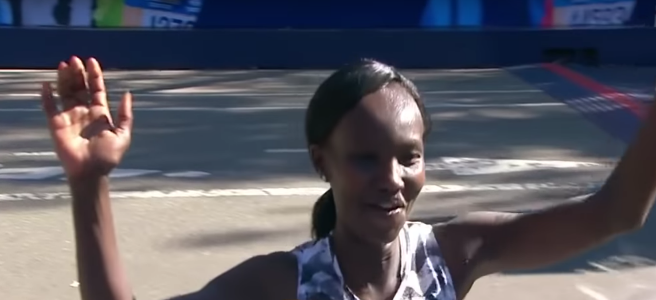New York City held a mild, windless marathon this year.
The eventual winners employed the most effective strategies on the day, keeping their composure when competitors continued to test them, finishing strong.
Steady Start Helps those with Greater Capacity
Before the marathon I predicted that it would be extremely difficult to beat Mary Keitany. Not only had she won the event three times before but she is undoubtedly one of the greatest female marathoners ever, alongside the UK’s Paula Radcliffe.
The race began with a huge pack, and stayed that way for the first half of the race, which was completed in 1:15:50. If the pace had continued it would’ve meant a relatively slow winning time (Kenya’s Edna Kiplagat’s 2011 performance of 2:28:20 was the most recent winning time that would have been slower).
But, unsurprisingly twenty runners soon became eight as the pace steadily increased. Keitany began to lead the pack, but soon Rahma Tusa of Ethiopia and Vivian Cheruiyot of Kenya surged. A 10-second gap quickly appeared. Only Keitany stayed with them.
Keitany had the impetus to keep the pace fast. Cheruiyot fell back, then Tusa had to let Keitany go. By 30km Keitany had begun her ‘victory lap’. She didn’t need to look back; the gap was growing with every stride.
She broke her competitors by running three consecutive 5km splits under 16:30. Her efficient stride, short, powerful arm swings (similar to Juliet Chekwel) helped her to win by over three minutes and record the second-fastest course time.
Know One’s Limits
It’s easy to comment that some of the athletes should have pushed the early pace to keep Keitany from running a huge negative split (she ran the second half of the race more than fifteen minutes faster than the first half). But every athlete needs to run their own race strategy. The relatively comfortable early pace meant that Americans Stephanie Bruce, Brittany Charboneau and Desiree Linden could all front run for short periods.
The danger is that by attempting to keep with a superior runner, as Tusa did, runners can compromise their race. Overstretching, especially during a marathon, can lead to a loss of a podium finish. Alone, Vivian Cheruiyot could run at the pace she needed during the last miles, finishing strong in second. The American Shalane Flanagan, last year’s champion, could also run within herself, eventually breaking away from the chase pack and completing the podium. Tusa faded, finishing in fifth position.
The experiences of Cheruiyot and Flanagan, who are both in their thirties, ensured that they kept a tight grip on the top placings.
Always Have More to Give for the End
Whilst the elite women made their move just after the halfway mark, the men’s race was decided in the final mile.
The elite field was strung out in a line by 5km, with Ethiopia’s Lelisa Desisa and Shura Kitata, and Kenya’s Tamirat Tola and Geoffrey Kamworor pushing the pace.
As the race progressed Kitata held the lead, but couldn’t break away. The frequent undulations kept the runners together until 35km, where Tola couldn’t respond to the surge from Kamworor.
Pre-race I believed the defending champion would be too strong for the Ethiopians, and like Keitany, was conserving energy before his fast finish. When Kitata fell back during the last mile, it seemed the Kenyan had only one competitor left. But it was Kamworor who couldn’t maintain, with Kitata fighting back and pushing his training partner and fellow countryman to the end.
Desisa had deceived everyone, quietly keeping back so that he could give his all when it was most needed. The Ethiopian, who had attempted to break the two-hour marathon last year with Eliud Kipchoge, had finished in the top three on three other occasions, and at the finish line his delight was clear to see.


2 thoughts on “Waiting to Pounce at 2018 NYC Marathon”